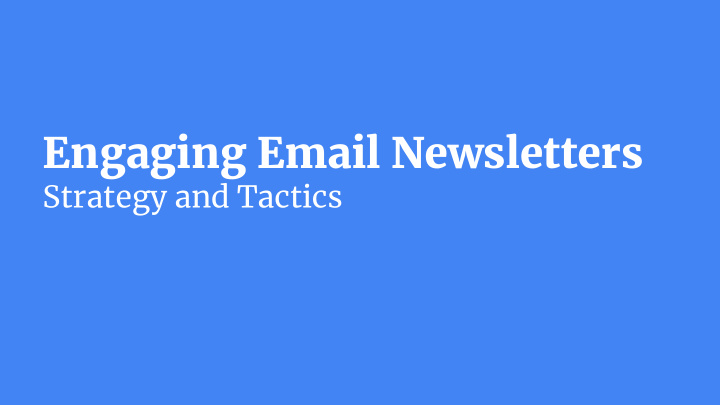



Engaging Email Newsletters Strategy and Tactics
Email is one of the biggest opportunities in the digital space — and most people aren’t talking about it.
Let’s discuss... ● Why should I invest in email? ● How do I make emails that readers love? ● Which email products should I launch next? ● How do I measure success with email?
Why should I invest in email?
Email is a tool for building What’s this presentation about? Use this slide to introduce yourself relationships. and give a high level overview of the topic you’re about to explain. There isn’t a single entity or algorithm that controls email. If you can get a reader’s email address, you can build a relationship with them for the long haul.
Email is a living room. What’s this presentation about? Use this slide to introduce yourself and give a high level overview of Subscribers allow in a the topic you’re about to explain. handful of lucky guests — family, friends, and maybe your brand. Take advantage of the 1-to-1 nature of the inbox.
Email is a cross- functional tool. Email plays a key role in every part of your growth strategy: Driving traffic ● Growing your audience ● Building habit ● Increasing loyalty ● Reducing churn ● Converting readers to ● subscribers
Email is an engine that drives revenue for your org. You can use email to: Get more readers to ● your site. Build a relationship with ● these readers and convert them to subscribers, donors, or members. Make sure these readers ● keep supporting your work year after year.
How do I make emails that readers love?
How do I make emails that readers love? Rule #1: Content is king, but distribution is queen (and she wears the pants)
How do I make emails that readers love? Rule #2: Create habits and routines
How do I make emails that readers love? Rule #3: Start with a building block ● Identity ● Service ● Utility ● Personality
How do I make emails that readers love? Rule #4: Trust is hard to win and easy to lose
How do I make emails that readers love? Rule #5: Direction is more important than speed
Which email products should I launch next?
Traffic-driving newsletters These are newsletters primarily designed to drive readers to your site to read a story.
Destination Newsletters These are newsletters designed to be read in the inbox. They sometimes link out to your site, but the primary goal is deliver value for a reader without requiring them to click.
Alerts These are emails that alert a reader when a certain type of story (i.e. breaking news, or a new article from a featured writer) is published.
Courses These are an automated series of emails that get triggered after a certain action. They’re designed to teach you a new skill, habit, or lesson. If a reader signs up today, tomorrow, or a year from now, they’ll receive the Course in full.
Pop-up products These are newsletters that only run for a limited time. They’re products designed to inform or educate around a specific event.
1.) Launch a daily newsletter A great daily newsletter: Builds habit ● Drives daily ● engagement Can be incredibly ● effective at converting casual readers to paying supporters Can help reduce churn ●
2.) Launch an onboarding series A great onboarding series: Establishes a ● relationship with the reader Guides that reader ● through the next steps on their journey Drives engagement ● from Day 1 Improves inbox ● placement for your newsletters
3.) Launch a personality- driven product The best personality- driven newsletters: Showcase unique ● voices in your newsroom Reinforce the value of ● your organization Are built around ● serving specific audiences — not verticals
Let’s workshop! Audiences / Identities Jobs / Services Who your readers are What readers need from you ● ● What they care about What you do uniquely well ● ● What they do ● What they like / dislike ●
Next steps Take what you’ve ● learned here and apply it to your newsletters Audience + Job + ● Building Block = ? Go to bit.ly/newsletterworkshop to download the worksheet
How do I measure success with email?
How do I measure success with email? ● Start with open rate — but focus on unique open rate. Unique open rate measures the unique number of subscribers on ○ your email list who opened a specific email, and tends to be far more accurate than total open rate. Check with your ESP to understand how they calculate open ○ rate, since it varies by ESP.
How do I measure success with email? ● Other metrics to monitor: Monthly list growth — How much an individual email list grew ○ this month. Click-to-open rate — The percentage of readers who opened an ○ email and clicked on at least one link. The percentage of readers who open 50%+ of newsletters per ○ month — The percentage of readers who are habitual readers of your newsletter.
How do I measure success with email? ● Other metrics to monitor: Engaged minutes per newsletter — The amount of time that ○ readers spend on your site after clicking through from a newsletter. Unfortunately, tracking engaged minutes inside your ■ newsletter is nearly impossible to do at this time.
How do I measure success with email? ● Other metrics to monitor: Mobile open rates — The percentage of readers who open an ○ email on a mobile device. Clicks/1000 — How much traffic a newsletter drives for every ○ 1,000 emails sent. Conversions to paid — What percentage of your newsletter ○ audience converts and becomes a paying supporter of your news organization.
2020newsletterchecklist.com Five steps to improving your email program in 2020
2020newsletterchecklist.com Register there, and I’ll send you the full checklist + slides!
notanewsletter.com dan@inboxcollective.com
Recommend
More recommend